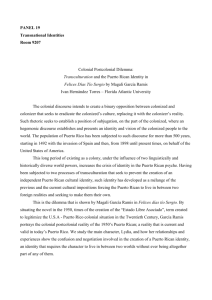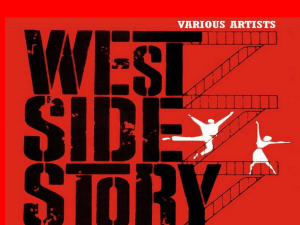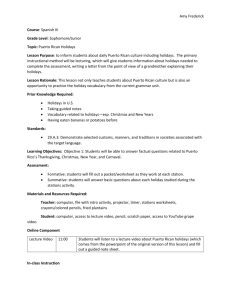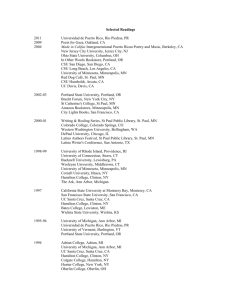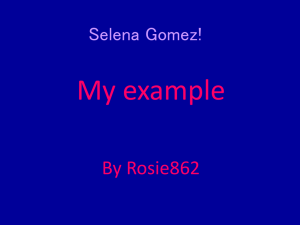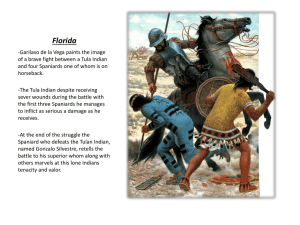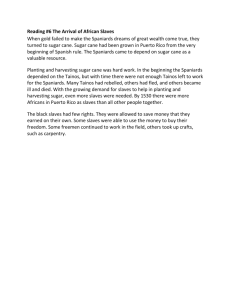JW`sChanges2Waldron`s McOndo.1
advertisement
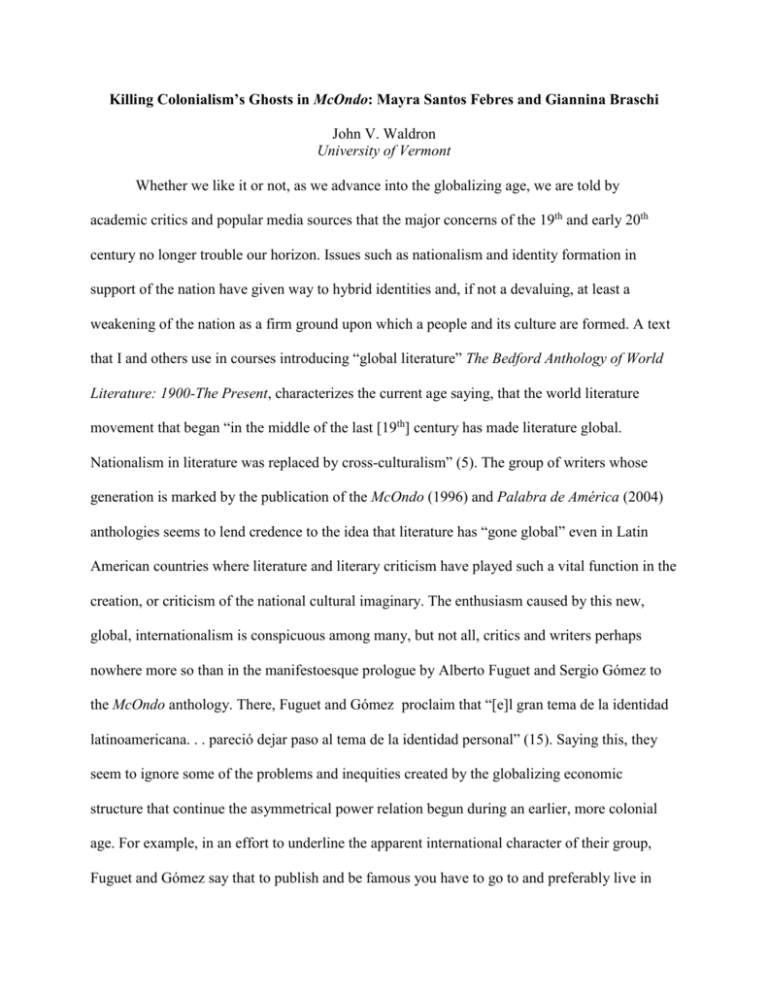
Killing Colonialism’s Ghosts in McOndo: Mayra Santos Febres and Giannina Braschi John V. Waldron University of Vermont Whether we like it or not, as we advance into the globalizing age, we are told by academic critics and popular media sources that the major concerns of the 19th and early 20th century no longer trouble our horizon. Issues such as nationalism and identity formation in support of the nation have given way to hybrid identities and, if not a devaluing, at least a weakening of the nation as a firm ground upon which a people and its culture are formed. A text that I and others use in courses introducing “global literature” The Bedford Anthology of World Literature: 1900-The Present, characterizes the current age saying, that the world literature movement that began “in the middle of the last [19th] century has made literature global. Nationalism in literature was replaced by cross-culturalism” (5). The group of writers whose generation is marked by the publication of the McOndo (1996) and Palabra de América (2004) anthologies seems to lend credence to the idea that literature has “gone global” even in Latin American countries where literature and literary criticism have played such a vital function in the creation, or criticism of the national cultural imaginary. The enthusiasm caused by this new, global, internationalism is conspicuous among many, but not all, critics and writers perhaps nowhere more so than in the manifestoesque prologue by Alberto Fuguet and Sergio Gómez to the McOndo anthology. There, Fuguet and Gómez proclaim that “[e]l gran tema de la identidad latinoamericana. . . pareció dejar paso al tema de la identidad personal” (15). Saying this, they seem to ignore some of the problems and inequities created by the globalizing economic structure that continue the asymmetrical power relation begun during an earlier, more colonial age. For example, in an effort to underline the apparent international character of their group, Fuguet and Gómez say that to publish and be famous you have to go to and preferably live in 2 Barcelona (13). This necessity reminds the reader, if not the authors, that Wallerstein’s concept of the “world system” of center and periphery still seems to be in place. However, the emphasis in McOndo and elsewhere is on openings and so called “cultura bastarda” more commonly called “hybrid culture.” Similar to avant-garde movements at the turn of the 19th century, here the weight of the past is thrown off as a new globalized order is embraced. If Barcelona is the cultural center for literature, Fuguet and Gómez proclaim it is also the case that the center no longer has the power it once did in dictating cultural norms; as the editors say, “España ya no es la madre patria” (19). At the dawn of the 21st century, the old constructs of modernity seem to have disappeared along with all of the problems and inequities in the new, exuberant age of globalization. However, in spite of their vigorous claims to the contrary, Fuguet and Gómez still seem unable to escape the grip of the economic, if not cultural and political, world system that has governed global relations since the dawn of European colonization of the Americas. Culture may be hybrid, but there is still a center or centers of power that have an impact on how culture is formed. As they mention, Barcelona forms one center around which Latin American writers should orbit. This is one example of how globalism, at least as it is now articulated, despite its claims does not represent a complete overcoming of modernity. Rather globalism, along with its positivistic ethos and positive attitude, is but a continuation of modernity’s salvational and quite often empty rhetoric (Mignolo “Citizen” 311). In order for the project of modernity to be truly overcome, critics and global citizens must deal with modernity’s so-called underside, coloniality. As Mignolo argues, “you cannot have modernity without coloniality; the unfinished project of modernity carries over its shoulders the unfinished project of coloniality” (312). Modernity and globalism, a new iteration of the modernity project, are therefore haunted by a colonial past and 3 by the incompletion of modernity’s own emancipatory project. This haunting is evident in Fuguet and Gómez’s statement of independence from “la madre patria España” while at the same time conceding that Spain controls the majority of Spanish language publishing houses. So Spain’s control over Latin American culture at least is not completely dead, yet it is dependent on the new life given it by the energetic new writers in Latin America for its own survival. Like a zombie or vampire, coloniality haunts literary production with its undead spectral presence. Perhaps nowhere is the undead condition of modernity and globalism more evident than when discussing Puerto Rican literature. Aside from the idiosyncrasies of a particular artist that set her or him apart from the others making their work distinct, with Puerto Rican artists the question of the Island’s own colonial situation usually makes their work, at some point, inassimilable to other global or even pan-Latin American literary movements. There are exceptions to this rule as is the case with the work of Luis Rafael Sánchez’s La guaracha del Macho Camacho (1976), Ivan Silén’s La casa de Ulimar (1988) or Manuel Abreu Adorno’s novel No todas las suecas son rubias (1991 posthumous). Though his work seems to be a secret when searching the literary histories or the official literary canon, Abreu Adorno (1955-84) may not be so unknown to Puerto Rican writers. Edgardo Rodríguez Juliá (b. 1946) in an article written by a staff writer for the Puerto Rican daily, El Nuevo Día called “Rinden tributo a Manuel Abreu Adorno,” mentions the latter along with Luis Rafael Sánchez (b. 1936) and Manuel Ramos Otero (1948-90) as important influences on his own work and that of other writers like Ana Lydia Vega (b. 1946) who, in turn are the precursors to the most recent generation of writers such as Mayra Santos Febres (b. 1966), Pedro Cabiya (b. 1971), Giannina Braschi (b. 1953) and others. The writers whom Rodríguez Juliá mentions here connect him and other Puerto Rican writers to global literary movements. By that I mean that the particular 4 writers Rodríguez Juliá mentions can be seen as being less concerned with performing national identity in their works and more aligned with pan-Latin American literary movements like the Boom or with the more recent McOndo group. Despite his tipping of the hat to the lesser known Abreu Adorno, Rodríguez Juliá’s statement, like most Puerto Rican literature, is haunted by colonial presence. Shortly after he mentions Abreu Adorno, Rodríguez Juliá says that he always writes thinking about how his work would be received by the likes of canonical writers such as René Marqués, José Luis González and Pedro Juan Soto. These are all canonical writers who are decedents of “the generation of 1930” who felt their primary purpose as artists was to defend the nation by consolidating national identity in their texts.1 Their work not only influences all Puerto Rican literature coming after, they also set the standard of expectations in the minds of Puerto Rican readers; that all literature respond to the issue of its colonial status. Even though he mentions the work of authors like Abreu Adorno who have deep connections with writers throughout Latin America,2 Rodríguez Juliá is more preoccupied with creating a link between himself and the official Puerto Rican literati. His work, as well as that of most Puerto Rican authors, is haunted by the demands placed on them by the colonial situation. In order to resist colonialism, the established elites created official entities like the Instituto de Cultura Puertorriqueña in order to use the arts to create a strong sense of nation. But, as with any definition, the limits of nation also create exclusions and repressions. Recently, in part due to the influence of globalizing culture, writers and critics have begun to question the limitations on subjectivity as well as the officially disseminated definition of nation. Jorge The history of art’s important role in the resistance of colonialism is detailed in works by Arlene Dávila, Arcadio Díaz Quiñones, and Juan Gelpi. 2 On February 2, 2006 Roberto Ampreu proclaimed in the Chilean online newspaper La Tercera that “el precursor latinoamericano secreto del McOndismo: [es] Manuel Abreu Adorno.” 1 5 Duany, noting the migrations between the Caribbean islands and Puerto Rico as well as migrations from Puerto Rico to the U.S., asks: “Under such fluid conditions, what is the meaning of Puerto Rican identity? Where is it located? How is it articulated and represented? Who imagines it and from what standpoint?” (2). The same questions he poses are those that writers in Puerto Rico are wrestling with. Are they still supposed to imagine the nation? And are they limited to this function? In her essay, “Sálvese quien pueda: la censura tiene auto,” the Puerto Rican writer Ana Lydia Vega notes how the pressure to represent history and tales of identity in art has led artists to a state of “autocensura” or self-censorship. She shows how the role that has been imposed on the artist since the 1930s, while making the artist very important in the public eye, also comes with limitations. To be officially recognized, to be funded, published and read, the artist had to unearth historical connections to a largely Spanish past, and represent a unifying image of Puerto Rican identity that was not entirely inclusive.3 Along with the restrictive definition of nation are the limits authors have to place on themselves in order to perform their role as arbiters of identity. This means that writers “self censor.” Describing what goes on during the writing process Vega notes “una vigilancia permanente sobre la eterna rebeldía de las palabras, lo que equivale a decir una autocensura a tiempo completo” (84-5). So, along with the typical artistic struggle of finding the “mot juste,” the Puerto Rican artist is also distressed by monolithic thinking and the permanent vigilance in the society of control created by official responses to 3 As Eleuterio Santiago Díaz notes in his book Escritura afropuertorriqueña y modernidad, Afro-Puerto Rican culture was largely excluded from popular and official representations of Puerto Rican culture. 6 colonialism. The need to perform the nation in their writing as a response to the colonial situation has placed a very strong and effective filter between the artist and her work. Vega’s parodic stories, with their ironic half-smile at tradition, mock the self-importance of writers in previous generations who created and sustained Puerto Rican identity. Using parody, Vega’s stories form part of the past and part of the canon while at the same time distancing herself and her readers from it. Her stories still represent Puerto Rican realities that often focus on the oral tradition so important for the social-realist testimonial novel. However, as with any parody, her stories re-tell the past and present in a way that encourages more openness to change and difference. She looks for independence from the autocensura imposed by the colonial situation by poking fun at the important role that has so often weighed down writers who feel the need to re-create the past in the present and creates the possibility for works that are not limited to the function of representing national identity. Unlike Rodríguez Juliá, who still feels the pressure from the ghosts of the past, Vega still sees the ghosts but she laughs at them as she does, for example, in the story, “Sobre tumbas y héroes: (Folletín de caballería boricua)” (1987). In that story, two young people go to the mountains to find the tombs of the fallen heroes who died in “El grito de Lares,” a revolutionary uprising against Spain. But, in the process, they encounter other ghosts who are anything but worthy of the typical, sanctified national heroes. The ghosts of colonialism and history are still there, but Vega’s laughter renders them less effective (Reyes). For many critics, the necessity of constructing national identity to resist colonialism has become a lifeless pursuit. The Puerto Rican historian and cultural critic Carlos Pabón argues that the migrations of culture, people and goods in recent years have rendered the concept of nation ineffectual. In his aptly titled La nación postmortem: ensayos sobre los tiempos de insoportable 7 ambigüedad, Pabón says that the continuous migrations of peoples and the mulitple diasporas “ha[n] expuesto e intensificado la crisis de la nación Estado al poner en evidencia que los Estados nacionales no tienen formas adecuadas de definir la relación entre ciudadanía, lugar de nacimiento, filiación étnica e identidad nacional” (384). The previously existing bond between land, people and nation has broken causing Pabón and others to wonder “¿Para quién sirve la nación?” (376). That is to ask, since the national icons and other means of representing the nation do not reflect the lives of the people who identify themselves as Puerto Rican, who is benefiting from these images? Even though as a concept it no longer approximates the reality lived by people calling themselves Puerto Rican, the nation continues to haunt and even, from time to time, bite. Critics like Pabón have been accused by some Puerto Ricans of being “melones”; that they are green or “independentistas” on the outside and red or “demócratas” on the inside. That is that they act like they are independentistas to get jobs at the university, but are really demócratas in favor of the status quo (Torrecilla 135-7). As the name calling implies, the nation, at least as a concept or ideal, is not dead for some members of society. It still serves a purpose for some group of people even if the majority of Puerto Ricans cannot fully identify with its ideal. However, if in Ernst Renan’s terms, the nation requires a daily plebiscite from its citizens, Pabón argues that they are voting, not for one that is limiting and holds up an unreachable and unreal ideal, but rather they are in favor of a definition of nation or citizenship that recognizes their “multinational” and global bonds. That is because by their acts, what they buy, the values they hold, the dreams they have, Puerto Rican citizens show that they identify with images and icons that have little if anything to do with the traditional values of the Puerto Rican nation as defined by elite classes. The modern idea of the nation based on a link to the land and stability is no longer functional. As Pabón says, “La 8 globalización no implica […] la desaparición de ‘lo nacional.’ Lo que sí sugiere es la disolución de la pretensión de homogeneidad cultural ligada históricamente a la nación moderna, y la expansión desigual y segmentada de culturas híbridas mundializadas” (370). It becomes a multinational assembly, a flexible articulation of parts (García Canclini 16). As the worldwide popularity of Reggaetón-- a musical form born in Puerto Rico by two returning members of the Diaspora-- shows, the mixing of elements from different cultures into a single mutable construct, an open ended hybrid, is something that the general public finds appealing, and it is something they identify with. They show their support by purchasing discs, downloads, T-shirts and concert tickets. Though this might point toward the end of the nation as we know it and signal an entry into a more egalitarian age marked by globalized consumption of products, the nation refuses to die. The nation and colonialism continue to haunt Puerto Rican literary production as well as thought as is made obvious by Rodríguez Juliá’s need to assure his readers that his priority is satisfying the ghosts of René Marqués and Pedro Juan Soto. Censorship is still on autopilot. For Puerto Rico, as with all colonies, the colonial relation between colonizer and colonized is the defining limit of power and the imagination. There is perhaps no fantasy more preponderant in the colonial relation than the one of liberation from the bonds imposed by the colonial master. Imagining the nation and a unifying identity reaffirms the limit defined by the colonial situation since such a process is a means of resisting the impositions of colonial power. You cannot resist something that does not exist, so to resist colonialism reaffirms its presence and authority. As the Puerto Rican critic and philosopher Rubén Ríos Ávila puts it, [l]a condena más onerosa que el amo le impone al esclavo en la estructura colonial es la de la libertad, la de conformar su subjetividad a partir de la utopía redentora de su eventual liberación […] Ahí radica la violencia, el acto hegemónico por el que se cifra la relación entre el imperio y sus subordinados, entre el capital y sus víctimas. (32) 9 For Ríos Ávila, the hegemonic act of violence that marks the relation between the Empire and its colonies is the circumscription of memory and the imagination. That is, the colonial subject’s memory is limited to retelling a utopian, pre-colonial past and its imagination to fantasizing independence. The colonial relation therefore haunts memory and imagination posing a demand that limits representation. The colonial relation might seem to form an impasse for Puerto Rican writers, one that limits them from full participation in a group like that formed by Fuguet and Gómez for whom, “[e]l gran tema de la identidad latinoamericana (¿quiénes somos?)” is exchanged for “el tema de la identidad personal (¿quién soy?)” (15). Imperial power, a form of colonialism, is no less a part of Fuguet’s and Gómez’s past than it is for any part of Latin America or the Caribbean. In fact, Pinochet’s rise to power in Chile—the country both Fuguet and Gómez come from-- was orchestrated by the U.S. as was his later reign of terror. The editors of McOndo, as is the case for the writers it includes, make a conscious decision to no longer allow Empire or its limits to restrict their imaginations or their memories. They arrive at an emphasis on the personal by ignoring and even thumbing their noses at the pressures of the new colonialism, globalizing capitalism. They do this by not conforming to the demands of foreign editors and publishing houses that expect Latin American literature to produce magical real narratives, texts that are concerned with national identity or those that transparently reflect Latin American reality such as testimonials or autobiographies. A similar decision has been made by several Puerto Rican writers with different effects; two I would like to focus on here are Giannina Braschi and Mayra Santos Febres. Braschi’s entire opus would fit nicely within the parameters outlined by Fuguet and Gómez, since it is more concerned with personal identity and the interrelations of subject and other. Mayra Santos Febres’s first novel, Sirena Selena vestida de pena (2003), would also 10 fit in with the McOndo group, but her most recent novel, Nuestra señora de la noche (2006), demonstrates signs of colonial hauntings. This last novel shows how powerful the grip of colonialism is in Puerto Rico and how forceful are the ghosts of its past. Braschi’s, Yo yo Boing (1998) is a novel that is told oscillating between Spanish and English. At times Braschi uses the same verbal play one would expect in any interlingual text written by a member of the Diaspora, but there are also entire chapters, like the first one, told in Spanish with little influence of English. The first chapter or section aptly called “Close-up” begins with the narrator looking at herself closely in the mirror. This interior inspection results in all sorts of fluids flowing out of her in ways she cannot control. She wants to excrete something, a bowel movement or the pus from a zit, but is unable to produce it in a way that is entirely satisfactory to her. Instead a lot of other fluids come leaking out, or the pus comes out preceded by blood, something she did not desire. This close inspection of the self and the uncontrollability she finds reveals the innermost aspect of her being and her relation to it. In psychoanalysis, excrement and other internal fluids are the so-called “mysterious X” of our being, the part that remains secret even to ourselves. Freud talks about how children offer their excrement to others as a gift. This present should not be taken lightly since it represents a part of the child that is from her or his innermost being. It therefore oscillates between sublime gift of the innermost and just plain excrement. This is precisely the reason why for Lacan one of the most important things that distinguishes human beings from animals is how they deal with their own defecation. Humans feel the need to hide it or flush it away not only because it smells, but because it “came out from our innermost. We are ashamed of our shit because in it we expose/externalize our innermost intimacy […] It comes from inside the body, and this inside is evil, criminal” (Žižek 257). Braschi’s novel, told in a rather energetic stream of consciousness style using prose, poems 11 and drama forms, becomes this gift of the innermost mystery of her self. As such its meaning remains a secret even to her. Writing here is anything but the transparent representation one expects with a testimonial novel or from an autobiography. The struggle between personal identity and writing is one that underlies the entire novel. In some ways, then, it is an autobiography, and even perhaps a Kuntslerroman, telling the story of the artist. But if it is a portrait of the artist, the novel also shows how subjectivity and identity are elusive since they are barred by language. In the opening section, “Close up,” the narrator says, “Oh, espejo mágico” conjuring up the traditional, Sleeping Beauty myth, and looking for the truth, the real answer to her questions so that she can at last know who she is and begin to write. But here the mirror only makes her wonder more, “te fragmentas en tantas expresiones, cuál de todas es real, cuál le miente siempre” (27). In the psychoanalytical “mirror stage” the person looking into the mirror sees a unified image that he or she partially identifies with. I say partially because, even as the looker notices her own image staring back at her, she also realizes that the image that is captured does not represent the entirety of who she is; there is an interiority not seen in the reflection. Complicating matters here, the mirror is also fragmented, so the experience of partial unification in a “mirror stage” – where one mirror is always implied-- is forestalled as is the evolution of the subject in its relation to its other, language. Her investigation into self continues as she stares into the mirror, “cuál (imagen) teme que sea la llamada no de la muerte, que es demasiado real, sino de la misma muerte que es la realidad, que no come cuentos ni se embarra de maquillaje” (27). She fears reality, not the reality of death because it is “too real,” but of realism, a reality that literally “doesn’t eat stories” that is to say one that does not listen to or believe “lies” and one that “doesn’t muddy itself with make-up.” The choice of the idiomatic phrase “no come cuentos” (an idiom meaning that the person doesn’t put up with B.S.) 12 is particularly apt here since what is at stake is the relationship between reality and fiction. Here fiction, the act of telling “cuentos” and of painting over the real face with make-up, fears the knock of reality at the door because reality or truth will destroy the image she sees in the mirror, the idea she has of herself thrown back to her in a fragmented reflection. But these desires and fears she sees reflected are also fragmented. One image fears reality while the other might embrace it, the subject here is splintered into pieces that the looker, or the reader for that matter, cannot combine into a coherent image. She is unsure which one “no come cuentos” and which one creates them. The chapter continues in this stream of consciousness interior exploration until, at the end, there is a birth of sorts into language. This birth, representing as it does the subject’s relation to language, shows how language cannot fully express or speak. In what might be read as a commentary on the eternal and primordial question of ethnic or subaltern studies, “can the subaltern speak?” the narrator says, “abre la boca pronunciando ciertas palabras mudas” (29-30). Language, like her bowels, seems to be constipated and it is only with the long, intense interior inspection that language begins to emerge from her innermost, mysterious X. But language, a definite form, cannot encapsulate the innermost X. Language offers us the capacity to represent the truth of our innermost self, but at the same time, there is always a remainder, an X, that must remain outside. This is why our excrement is so offensive and so evil; it shows us and others that part of ourselves that cannot be contained within language. If language is the basic element used to speak about and even construct identity, whether personal or national, then her interior exploration and its result also question the limits created by Puerto Rico’s colonial situation and by globalizing capitalism. Though she does not mention it here, my critical mind trained to seek historical continuity between texts wants to place her text 13 in relation to the other great works of Puerto Rican literature and the specters of the past that haunt Rodríguez Juliá and others. If I do that I read her text as the undesirable something that the colonial relation cannot contain. That is since her text does not seek independence from coloniality, then it is not “condemned” in Ríos Ávila’s words, to imagine liberation from the bonds of the interminable colonial situation. Here the liberation the “I” of the narrative seeks is the same one all subjects want: to be free of the limits of language. But without language, one is unable to express one’s self, so one also needs its limitations. Language here is and is not enough. The narrator recognizes this. As she reaches the conclusion of the chapter she says that letters are “hechas de formas que han producido formas, han estrechado la mesura de sus formas” (30). Language creates a chain of signification propelled by the desire to understand precisely what it cannot represent, the innermost X. Yet representation becomes a symbolic means of representing that thing X ¿thatreally? cannot be controlled. Conscious of the connection between language, speech and the body, Braschi in the last two pages connects the movements of the mouth with vowels and language. The “Close up” ends with a distancing effectuated by the limits of language. The narrator seems to be in control when she says, “consciente en el movimiento lento y pausado, consciente del movimiento que hace cuando se cierra y se abre, control supremo de uno mismo sobre su propia muerte que observa cerrando los ojos” (31). As the body tries to speak, it is at first mute, but as the body slowly learns how to enunciate, language exercises control over the body. And the self seems to have arrived at control of itself, its bodily fluids and even its own death. This feeling of mastery immediately gives way to a sense of alienation and division. The narrator becomes aware of the deal she has made in order to gain some limited mastery over her self. Language offers us the capacity of representation along with the ability to communicate our 14 thoughts, desires and dreams to others. However the price we pay for this is that we must hide part of our self, that part that is “not fit for society” and that part which will not fit in language. All thought of interior fluids and excrement have vanished in the final pages as her focus is on how the mouth shapes vowels and how vowels become words and how this activity eventually exerts control over the bubbling mass of fluids that flow in her body. The narrator ends the chapter saying, “en la unión con el cuerpo del cuerpo que se muere y se abre, se contrae y se apaga y se divide y se cierra de todas partes y por todas partes lleno de permanencias” (31). The subject contracts, divides and closes off in order to submerge that part of itself, that mysterious X, that it cannot bring into representation at the risk of upsetting the order and of not being allowed to or able to speak. The struggle with language continues throughout the novel. Mayra Santos Febres’s first novel, Sirena Selena vestida de pena like Braschi’s text, decidedly ignores Puerto Rico’s colonial situation and is free of the specters that haunt the work of previous generations like Edgardo Rodríguez Juliá. Santos Febres’s novel starts out with what we are led to believe at first are two women traveling to the Dominican Republic. We soon find out, due to the shifting signifiers indicating gender, that they are “dragas” or drag-queens. Miss Martha Divine is taking Selena to meet wealthy businessmen in the Dominican Republic in hopes of getting a contract for her to perform in a nightclub, casino or hotel. The reason they have to leave Puerto Rico is that there are laws there that would prohibit Selena from performing in such an environment due to her age. It is possible to see here a commentary on global capital; labor laws are not the same everywhere thus allowing exploitation in some parts of the world and creating joblessness in others. There is also an ironic criticism of the prevailing Puerto Rican opinion regarding Dominican migration to Puerto Rico. Here the illegal labor goes in the other direction perhaps reminding the reader of the constant migrations of people and products, legal 15 and illegal, that have connected all of the Caribbean islands for centuries ignoring official, national boundaries that are, in reality, an imposition of European modernity (Carnegie 1-15). The nation as “logos center” or center of language and culture is entirely absent from this novel. In fact, it is the absence of the phallus that defines and limits language as the “phallologocenter” that allows Selena to be who she is, to express her true identity as transgender, and to perform her songs and “drag show” in a way that entirely mesmerizes her public. This reveals the true function of language as phallic discourse since the phallus, like language, signals the absence of the penis. As many have argued— unconvincingly for many feminists—the phallus is a sign that marks its absence and should be distinguished from the actual, physical penis. The phallus, like any symbol, introduces presence where there is really absence, “proclaiming, in effect, that this word (which is here) conveys this thing (which is not here)” (McGowan 24). The phallus is a sign that conveys its absence. The symbol hides the lack, or absence that is behind it and also allows us to hide or keep private from the public eye things we want kept free of intrusive observations. Selena’s hidden penis then allows for the act of creation, for representation; and it allows her to perform. Once it becomes present, there is no longer a need for symbols or language. Once the authority of the nation, as “phallologocenter” is ignored, and once the demand for literature that retells true histories is avoided, an exploration of other selves and the expression of other identities are possible as is the case in Sirena Selena. Once the penis becomes present the possibility of the secret or hidden around which it is possible to construct fables is removed, it is no longer possible to create or even speak. When Selena is forced to reveal his penis to Hugo—the wealthy businessman who tempts her with a contract--, she immediately disappears leaving no trace that either Hugo, the reader or Miss Martha Divine can follow. Up until that point, when her penis is hidden, it is obvious that 16 everyone is wrapped up in the simulacrum become reality that Selena has created. This simulacrum is similar to the “chain of words” that appear at the end of the “Close up” chapter in Yo yo Boing once the narrator begins to be able to speak. Describing Selena’s performance, the narrador says, “Y ella no puede explicarse por qué el público paga por verla sufriendo; ahora que pierde el aplomo de lo que antes era un simulacro perfecto” (253). In fact the word, “simulacrum” is used to describe Selena’s performances frequently in the novel, pointing out how images are built on top of one another in the absence of the penis’ totalizing presence. Hugo says to her repeatedly, “Te voy a amar, Selena, como siempre quise amar” (255). This is a line similar to the one he also says to his wife that indicates his own secret, a secret that is even one he keeps to himself, that he is gay and desires men not women. His wife, Solange, sees the effect that Selena’s performance has on her husband and the rest of their friends and, in the moment when it appears Selena has won Hugo over for good, Solange perfectly repeats Selena’s performance. It is Solange’s performance, one that connects her to Selena creating a “chain of signification,” that allows her to maintain her dignity and her friends even as her husband runs off with Selena. Retiring to her room the narrator says that Solange “Coteja su cara en el espejo.” The word “cotejar” can mean to compare something to another in terms of economic value as well as a partial proof that is practiced when the authenticity or originality of a document is unknown. Again creation here is simulacrum; Solange compares herself to the fiction Selena has created in the absence of the penis. In a scene that is similar to Braschi’s narrator looking in the fragmented mirrors, Solange “makes herself up” in the mirror creating an image to obfuscate the real drama and tragedy her husband has created by running off with Selena and leaving her home alone with all the invited guests. As she descends the stairs to her waiting guests, she is now the melodramatic figure that Selena 17 characterized earlier. The narrator uses stage instructions interrupting Solange’s stream of consciousness by repeating “(pie)” to indicate her steps down the stairs. This completes Solange’s imitation of Selena’s own creation since identical directions were used when Selena came down the same stairs during her performance. Though others are free to continue creating in her absence, the appearance of Selena’s penis puts an end to her performance, removing her secret and also her ability to confabulate symbols in its absence. Once her penis comes out, the illusion that she was a woman is removed. Hugo wakes up to realize that his own fiction about himself is destroyed by the real penis. He must now realize the reality that he likes having sex with men. He wakes up to see that Selena has robbed him of his money, watch and identity leaving him and the novel, all they have is memory and the newly created simulacrum that Solange enacts. In Sirena Selena, it might be possible to talk about the colonial aspects of globalism since Hugo’s relationship with Selena has overtones of sex trafficking, a problem that has intensified with globalism. But it is in Santos Febres’s recent novel, Nuestra señora de la noche, where the ghosts of the generation of 1930 seem to haunt the text showing the power of coloniality’s grip. The preoccupation in this novel is not so much with the universal struggle of the subject with its other or with the limits of language, but rather with representing Puerto Rican history in a way that is more inclusive. This novel retells the history of the wealthy Fornarís family as well as the life of Isabela la Negra, an Afro-Puerto Rican woman who owns a brothel and who is mother to one of the Fornarís patriarch’s unrecognized, illegitimate sons. In some ways the novel still demonstrates Santos Febres’s skill as a writer. It is told in intercalated flashbacks between the Fornarís family, Isabela and the stream of conscious ramblings of a “Virgin.” As these personal stories are told, they are interwoven into the fabric of the major events of Puerto Rican history 18 such as the Masacre del Domingo de Ramos, where a peaceful Independentista march was fired upon by government soldiers in support of U.S. colonialism. We also see the racism that the younger, legitimate, light skinned Fornarís, Luis, encounters when he goes to college at U. Penn. Through the retold life of Isabela we are also shown the pervasive racism in Puerto Rico. The last third of the novel shows the unification scene between the two brothers who, before joining the Army and being sent to the Phillipines, never knew of the other’s existence. The statement here is that colonialism and racism affect all of us, but we are all united, the blood of the same patriarch runs through us all. This novel with its new twist on a traditional genre, the historical novel or the novel about “la gran familia puertorriqueña,” recovers the past to reformulate a more inclusive national identity. Different from Santos Febres’s earlier novel, and certainly unlike Braschi’s, the blood of the past patriarchs flows through Nuestra señora’s veins and orders its creation. Similar to Rodríguez Juliá’s statement that first embraces Abreu Adorno’s decolonial imagination and then quickly mentions the dead, revered patriarchs of Puerto Rican letters, Santos Febres’s literary production, at least with her latest novel, responds to the haunting presence of colonialism by a return to nationalism. Writing in this novel is limited by the violent circumscription of colonialism, a concern that the McOndo generation and writers like Giannina Braschi are, apparently, able to ignore. Works Cited Ampreu, Roberto. “La deslumbrante literatura de Puerto Rico.” La Tercera Online. 19 Feb. 2006. Web. 2 May 2009. http://www.ciudadseva.com/obra/2006/02/19feb06c/19feb06c.htm Aviv, Rachel. “100 Years of Solitude on Crack.” Salon.com. 1 Jan. 2004. 19 Web. 5 May 2009. http://dir.salon.com/story/books/feature/2004/01/21/mcondo/index.html Braschi, Giannina. Yo yo boing. Pittsburgh: Latin American Review Press, 1998. Carnagie, Charles V. Postnationalism Prefigured: Caribbean Borderlands. Rutgers: Rutgers UP, 2003. Dávila, Arlene. Sponsored Identities. Philadelphia: Temple UP, 1997. Davis, Paul, Gary Harrison, David M. Johnson, Patricia Clark Smith, and John F. Crawford, eds. The Bedford Anthology of World Literature: The Twentieth Century to the Present. Boston: St. Martin’s Press, 2003. Díaz Quiñones, Arcadio. “1898: Hispanismo y Guerra.” 1898: Su significado para Centroamérica y el Caribe: ¿Cesura, Cambio,Continuidad? Ed. Walther Bernecker. Frankfurt am Main:Vervuert, 1998. 17-35. Duany, Jorge. The Puerto Rican Nation on the Move: Identities on the Island and in the United States. Chapel Hill: U of North Carolina P, 2002. Fuguet, Alberto and Sergio Gómez. McOndo. Madrid:Mondadori, 1996. García Canclini, Néstor. Consumidores y ciudadanos: conflictos multiculturales de la globalización. México: Grijalbo, 1995. McGowan, Todd. The End of Dissatisfaction? Jacques Lacan and the Emerging Society of Enjoyment. Albany: State U of New York P, 2004. Pabón, Carlos. Nación postmortem: Ensayos sobre los tiempos de insoportable ambigüedad. San Juan: Ediciones Callejón, 2003. Renan, Ernst. “Qu’est-ce qu’une nation?” Oeuvres Complètes. Vol. I. Paris: Calmann-Lévy. 1947-61. 887-906. 20 “Rinden Tributo a Manuel Abreu Adorno.” Endi.com. El Nuevo Día. 12 de octubre 1992. Web. 12 Dec. 2008. (website no longer available) Ríos Ávila, Rubén. “El relato del trauma.” La raza cómica del sujeto en Puerto Rico. San Juan: Ediciones Callejón, 2002. 15-42. Santiago Díaz, Eleuterio. Escritura afropuertorriqueña y modernidad. Pittsburgh: Instituto Internacional de Literatura Iberoamericana, 2007. Santos Febres, Mayra. Nuestra señora de la noche. Barcelona: Espasa Calpe, 2006. ---. Serena Selena vestida de pena. Barcelona: Modadori, 2003. Torrecilla, Arturo. “Watermelon Intelligentsia: Intellectuals in the Party-State.” Social Text 38 (1994): 135-47. Vega, Ana Lydia. “Sálvese quien pueda: la censura tiene auto.” Esperando a Lolo y otros delirios generacionales. San Juan: Editorial de la Universidad de Puerto Rico, 1994. 83-90. ---. “Sobre tumbas y héroes (Folletín de caballería boricua).” Pasión de historia y otras historia de pasión. Buenos Aires: Ediciones La Flor, 1987. 101-145. Žižek, Slavoj. “The Ideology of Empire and its Traps.” Empire’s New Clothes: Reading Hart and Negri. Paul A. Passavant and Jodi Dean, eds. New York: Routledge, 2004. 253-64.
